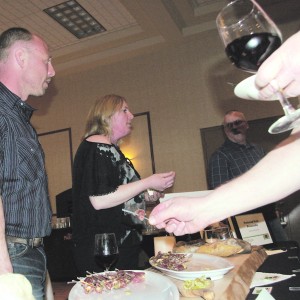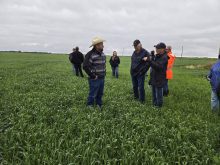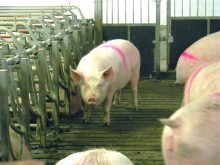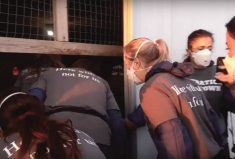 Clinton and Pamela Cavers are looking for a path through the bureaucratic and regulatory maze that has blocked them marketing their prizewinning meat products.
Clinton and Pamela Cavers are looking for a path through the bureaucratic and regulatory maze that has blocked them marketing their prizewinning meat products.
The Pilot Mound owners of Harborside Farms had their entire inventory of about 160 kg of charcuterie, which is cured pork and beef products, seized by health inspectors last week, a few months after those same products took the top prize worth $10,000 in the province’s annual contest for homegrown food inventors.
Read Also

Mazergroup’s Bob Mazer dies
Mazergroup’s Bob Mazer, who helped grow his family’s company into a string of farm equipment dealerships and the main dealer for New Holland machinery in Saskatchewan and Manitoba, died July 6 from cancer.
The two Manitoba Agriculture, Food and Rural Initiatives food inspectors who showed up at their farm last week seized about $8,000 worth of product, and handed the couple a $600 fine for selling what they deemed “food unfit for human consumption.”
The meat products were not found to contain any foodborne, illness-causing pathogen. Rather, they were told they must comply with certain procedures and processes, as well as upgrade their facilities to ensure no such pathogens have a chance to develop.
The problem is, there are no clear answers as to how they can meet those requirements.
“We’re having a very difficult time getting a clear sense of what those procedures and processes are,” Clinton Cavers said.
Even as they try to figure out how to do the proper testing to make sure they’re producing a safe product, complicating everything is that they can’t do any testing until they have the proper facilities.
Cavers said he called the deputy minister’s office immediately after the August 28 raid. They’ve since been told a MAFRI team will visit their farm this week to help sort this out.
“I’m assuming it’s going to be someone in business development to help us navigate through this so we can figure out how we can get this to work,” he said.
Cavers fears compliance with the required food safety precautions may prove too costly for a venture their size.
The food embroiled in the controversy was the farm’s charcuterie, a specialty meat product they’ve been making since 2008 using traditional Italian recipes. Charcuterie is also known as prosciutto, lonzino, and capicollo, bresaola, salumi and soppressata and made using a fermenting or drying process rather than cooking.
The charcuterie is a specialty product the Cavers are developing as part of their farm’s farm-raised meat business. They also direct sell meat from their grass-fed beef, heritage breeds of pastured pork, sheep, goats and ducks and geese.
The producers complied with a June order to stop making and selling the product.
“That wasn’t an issue,” said Cavers.
Inspectors have asked for separate drying and separate curing facilities and that means a significant capital investment to renovate their existing meat shop, he said, adding that could double the cost — to upwards of $200,000 — which they initially anticipated in their business plan.
“Our meat shop is not huge, where you can set up a complete drying room,” he said.
Food product makers usually seek help from the Food Development Centre (FDC) at Portage la Prairie when specialized facilities like these are needed before a product’s market is developed. But the Cavers said they don’t think FDC has the space to dedicate to this kind of product.
“We could probably be doing the curing and the salting (of the charcuterie) at the FDC, but I don’t think it has the facilities for doing all the drying,” he said.
“We’re going to be looking, at some point in time, having a year’s worth of pig hips hanging, let alone all the other smaller cuts that we’re doing and it’s going to take substantial room to do that.”
Glen Duizer, acting chief veterinary officer with MAFRI, wouldn’t discuss the particulars of the Cavers’ case due to privacy rules. But he said a product like charcuterie, which isn’t cooked, requires ongoing monitoring of product pH and moisture levels and precise records of that monitoring.
Charcuterie can’t be tested for food safety after it’s finished; it needs ongoing testing during processing, he said.
“If you do testing throughout the process of developing the product, then you have much, much better confidence that the product is safe, to the point that you don’t have to test for pathogens once it’s made,” he said. “Doing any testing after is worthless because it wouldn’t tell you anything you can rely on that the product is safe.”
Duizer added that while it’s “definitely a struggle” for smaller-scale producers to produce this kind of product, they cannot be exempt from the procedures needed to make it safely.
“It doesn’t matter whether you’re a large-scale processor or an artisanal producer, you have to produce a safe product,” he said.
“What the province wants them to do is do everything they can to produce a safe product and reach the point where they can market and sell that product safely.”
Cavers said best-case scenario will be to be given clear direction for how, as a smaller-scale operation, they can comply with these food safety requirements, he said.
“Worst-case scenario… they destroy the product and the department gets really antagonistic and makes it so difficult we can’t continue doing what we’re doing.”


















